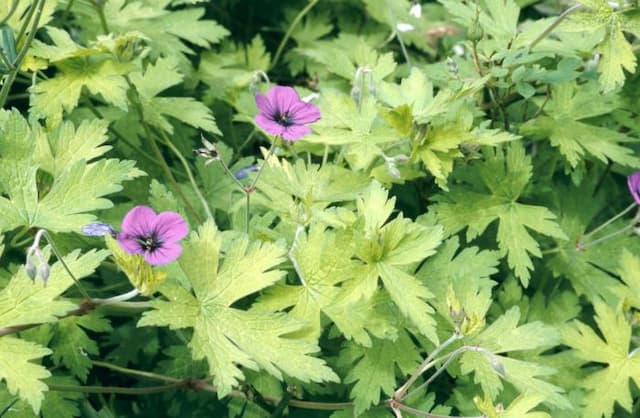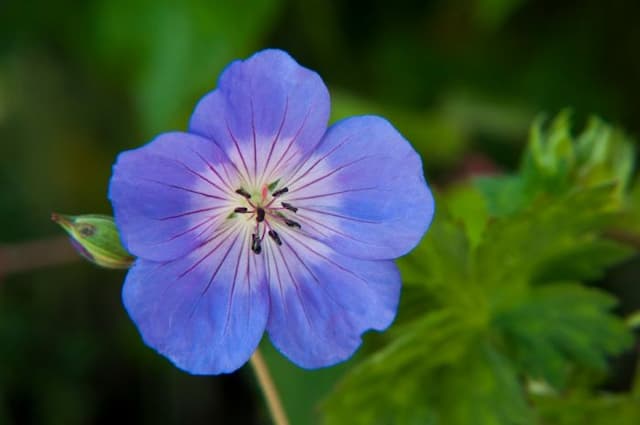Geranium Pelargonium 'Captain Starlight' (A)

ABOUT
Pelargonium 'Captain Starlight' (A), often referred to by the common name Geranium, is an ornamental plant known for its showy and vibrant appearance. The Geranium has dense foliage comprising rounded leaves that usually have a soft, velvety texture. These leaves are also distinctively marked with patterns or zones of a darker color, which add to the visual interest of the plant. The flowers of Geranium 'Captain Starlight' are particularly striking, held aloft on slender stems above the foliage. Each bloom is made up of several petals that together form a classic Geranium flower shape, which is slightly rounded and has a gentle yet defined structure. The petals themselves have a rich color palette, often displaying vivid hues that can range from deep reds to bright pinks, sometimes with contrasting markings or a gradient of color that adds to their allure. The overall appearance of the Geranium 'Captain Starlight' is lush and full, with a well-branched habit that provides it with a rounded and robust look. The charm of the plant lies in its ability to produce a profusion of these stunning flowers that draw the eye and become a focal point in any garden setting where they are featured.
About this plant
 Names
NamesFamily
Geraniaceae
Synonyms
Captain Starlight Geranium
Common names
Pelargonium 'Captain Starlight'
 Toxicity
ToxicityTo humans
Geraniums, including the Pelargonium 'Captain Starlight', are generally considered non-toxic to humans. However, ingesting large quantities of any part of the plant might cause mild gastrointestinal discomfort, such as vomiting or diarrhea.
To pets
Geraniums, including the Pelargonium 'Captain Starlight', can be toxic to pets, especially cats and dogs. If a pet ingests any part of the plant, they might display symptoms such as vomiting, anorexia, depression, and dermatitis. In cats, geranium toxicity may also lead to more severe reactions, including renal failure. It is important to keep these plants out of reach of pets and to seek veterinary attention if you suspect your pet has ingested some.
 Characteristics
CharacteristicsLife cycle
Perennials
Foliage type
Evergreen
Color of leaves
Green
Flower color
Mixed
Height
1-2 feet (30-60 cm)
Spread
1-2 feet (30-60 cm)
Plant type
Herb
Hardiness zones
10
Native area
South Africa
Benefits
 General Benefits
General Benefits- Visual Appeal: Adds vibrant color and visual interest to gardens and indoor spaces with its attractive flowers.
- Aromatic Foliage: Offers a pleasant scent which can enhance the sensory experience of a garden or room.
- Easy to Grow: Relatively simple to cultivate and can thrive with minimal care, making it suitable for novice gardeners.
- Insect Repellent: Naturally repels some types of insects, which can be beneficial when planted near outdoor seating areas.
- Drought Tolerance: Resilient to dry conditions once established, reducing the need for frequent watering.
- Long Blooming: Flowers for a long period, often from spring through fall, providing extended enjoyment.
- Versatility: Can be grown in a variety of settings, including pots, beds, and window boxes, adaptable to different garden styles.
- Edging Plants: Can be used as border plants to define garden spaces and pathways with their neat growth habit.
 Medical Properties
Medical PropertiesThis plant is not used for medical purposes.
 Air-purifying Qualities
Air-purifying QualitiesThis plant is not specifically known for air purifying qualities.
 Other Uses
Other Uses- Aromatherapy: The scented leaves of geranium can be used in aromatherapy as a means to promote relaxation and stress relief.
- Insect Repellent: Geranium plants are often planted in gardens or used in sachets to repel mosquitoes and other insects naturally.
- Flavoring Agent: The edible leaves of some geraniums can be used to flavor sugars, teas, desserts, and baked goods.
- Art Supplies: Geranium flowers and leaves can be pressed and used in botanical art or as natural dyes for fabrics and paper.
- Skin Care: Geranium essential oil, derived from the leaves, is commonly used in natural skincare products for its fragrance and purported toning properties.
- Garden Companion: Geraniums can be planted alongside vegetables like tomatoes and peppers to help deter pests with their pungent smell.
- Wedding Décor: The vibrant flowers of geraniums are often used in floral arrangements, including wedding bouquets and centerpieces.
- Education: Geraniums can be used as educational tools in schools for teaching botany and plant life cycles.
- Culinary Garnish: The bright and edible flowers of certain geranium species can add visual appeal and a slight flavor to salads and culinary presentations.
- Environmental Indicators: Some gardeners use geraniums as indicator plants as they can show signs of distress, such as wilting or leaf color changes, when garden conditions are not ideal.
Interesting Facts
 Feng Shui
Feng ShuiThe Geranium is not used in Feng Shui practice.
 Zodiac Sign Compitability
Zodiac Sign CompitabilityThe Geranium is not used in astrology practice.
 Plant Symbolism
Plant Symbolism- Comfort: Pelargoniums, commonly known as geraniums, are often associated with comfort due to their homely and familiar presence in many gardens and on windowsills.
- Friendship: Geraniums can represent friendship, signifying the bonds we create with others and the easygoing nature of maintaining those relationships.
- Health: Geraniums are sometimes used to symbolize good health, perhaps due to their use in traditional medicine and their refreshing fragrance which is believed to promote wellbeing.
- Positive Energy: With its vibrant colors and pleasant scent, the geranium is said to bring positive energy into a space, making them a popular choice for those wanting to create an uplifting environment.
- Longevity: The geranium's hardy nature and ability to flourish under various conditions are sometimes symbolic of longevity and the ability to endure life's challenges.
 Water
WaterFor a Geranium, including the Pelargonium 'Captain Starlight', regular watering is key to keeping the plant healthy. Allow the soil to dry out slightly between waterings, which typically means watering once every 1 to 2 weeks, depending on the climate and indoor conditions. When watering, it is recommended to use about 16 ounces of water for a standard 6-inch pot. However, this can vary based on pot size and environmental conditions. Always ensure that excess water can drain freely to prevent waterlogging and root rot.
 Light
LightGeraniums thrive in bright, indirect sunlight, making them suitable for east- or west-facing windows where they can receive at least 4 to 6 hours of sunlight daily. Direct afternoon sun might be too harsh and can scorch the leaves, so if you only have a south-facing window, place the plant a few feet away or use a sheer curtain to diffuse the light.
 Temperature
TemperatureGeraniums prefer moderate temperature conditions, ideally between 65°F and 75°F during the day, and not lower than 50°F at night. They can survive temperatures up to 80°F but should be protected from frost and temperatures below freezing. Keep Geraniums away from drafts and sudden temperature changes to ensure healthy growth.
 Pruning
PruningGeraniums benefit from regular pruning to encourage bushier growth and more blooms. Prune in early spring to remove dead or damaged growth and to shape the plant. Deadheading, or removing spent flowers, should be done as needed throughout the blooming season to promote continuous flowering. Cut back the Geranium by about one-third in late summer to prepare it for the next blooming cycle.
 Cleaning
CleaningAs needed
 Soil
SoilGeranium 'Captain Starlight' thrives in porous, well-draining soil with a pH of 6.0-7.0. A mix containing equal parts peat, perlite, and compost is ideal to provide the necessary drainage and nutrient content.
 Repotting
RepottingGeranium 'Captain Starlight' should be repotted every 1 to 2 years or when it outgrows its container. Repotting in spring allows the plant to settle before the growing season.
 Humidity & Misting
Humidity & MistingGeranium 'Captain Starlight' prefers moderate humidity levels; however, it is quite adaptable and can tolerate indoor humidity conditions typically found in homes.
 Suitable locations
Suitable locationsIndoor
Provide bright light, well-draining soil, and occasional watering.
Outdoor
Sunny spot, well-draining soil, protect from frost.
Hardiness zone
10-11 USDA
 Life cycle
Life cycleThe life cycle of the Geranium 'Captain Starlight', starts with seed germination, where the seeds must be sown in a warm, well-drained medium and require light to germinate. The germinated seeds grow into seedlings, which develop true leaves and are gradually acclimatized to outdoor conditions before being transplanted. As vegetative growth progresses, the plant forms a bushy structure with lobed leaves, and flowering stems. The geranium then enters the flowering stage, producing vibrant flowers that can sustain several rounds of blooming given proper care through deadheading and adequate nutrition. After the blooming period, if the flowers are left to pollinate, they will produce seed pods, completing its reproductive cycle. During the fall, geraniums can be cut back and overwintered indoors, or treated as annuals and allowed to complete their life cycle before succumbing to frost.
 Propogation
PropogationPropogation time
Spring-Early Summer
Pelargonium 'Captain Starlight', commonly known as Geranium, is most commonly propagated through stem cuttings. This is a simple and effective method that can be carried out in late spring or early summer when the plant is actively growing. To propagate, a healthy, non-flowering stem of about 4 to 6 inches (10 to 15 cm) is cut just below a node. The lower leaves are then removed, and the cut end is dipped in rooting hormone powder to encourage root development. The cutting is then planted in a pot filled with a well-draining potting mix and kept in a warm location with indirect sunlight. The soil is kept slightly moist, and within a few weeks, the cutting should develop roots and can eventually be transitioned to a permanent location.









